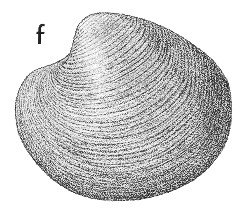
Revised descriptions of New Zealand Cenozoic Mollusca from Beu and Maxwell (1990)

 | Revised descriptions of New Zealand Cenozoic Mollusca from Beu and Maxwell (1990) | 
|
  (Pl. 29f): GS2423, U23/f8341, Ongaha Stream near Dannevirke-Mangatoro Road, 10 km east of Dannevirke, southern Hawke's Bay, Tongaporutuan (GNS) |
Beu & Maxwell (1990): Chapter 13; p. 258; pl. 29 f.
Synonymy: Kuia macdowelli Marwick 1927, p. 601
Classification: Veneridae: Venerinae
Description: Moderate-sized for family (47-56 mm long), length about 1.2-1.3 x height, with umbo at anterior quarter to third of length; umbo moderately to strongly protruding and inflated, descending rapidly in front to moderately large, heart-shaped lunule, bounded by narrow groove; posterior margin slightly quadrate, ventral margin deeply convex. Sculpture of unique broad, flat-topped, low commarginal ridges separated by very narrow, shallow grooves; lower edge of each ridge bears a low, very thin lamella in well preserved shells, but lamellae are abraded off most specimens. Almost all specimens are closed, articulated shells; interior ventral margin finely crenulate. Right valve hinge with long, low ligamental nymph, 3 narrow cardinal teeth (posterior pair partly fused but widely spaced), and 2 narrow, short, anterior lateral teeth margining large socket; left hinge not seen. Adductor scars of similar size, anterior one narrower and nearer valve margin than posterior; pallial sinus narrow, with rounded apex, directed at base of anterior adductor scar.
Comparison: Kuia macdowelli is readily distinguished from the much smaller K. vellicata (Kaiatan ?; Waitakian-Altonian; Pl. 11d, f) by its much lower lunule, its more quadrate shape, its markedly wider commarginal flat ridges and its much less obvious commarginal lamellae. Specimens from the Third Bay Sandstone (Lillburnian) at Clifden are similar to K. vellicata in most characters, but have sculpture intermediate between that of K. vellicata and that of K. macdowelli.
Marwick (1927, p. 601) did not state the derivation of the species name, but it is almost certainly named after Dr F.H. McDowall, a collecting companion of H.J. Finlay's at Clifden (see Fleming in Wood 1969, p. 72) and is probably spelled incorrectly.
Distribution: Waiauan-Kapitean; Park Bluff Formation, Clifden, Southland (probably from Nissen Shellbeds), Waiauan (type); moderately common at Clifden (Waiauan), Bluecliff, Te Waewae Bay (Kapitean), "Hurupi facies" diverse assemblages in Wairarapa, Hawke's Bay, Gisborne District, and North Canterbury (Tongaporutuan), and in a debris flow with mostly Kapitean and Tongaporutuan fossils in ?Opoitian mudstone, Little Wanganui River, Karamea, southwest Nelson; specimens of undoubted Opoitian age are not known to us.
Cite this publication as: "A.G. Beu and J.I. Raine (2009). Revised
descriptions of New Zealand Cenozoic Mollusca from Beu and Maxwell (1990). GNS
Science miscellaneous series no. 27."
© GNS Science, 2009
ISBN
978-0-478-19705-1
ISSN 1177-2441
(Included with a PDF facsimile file
copy of New Zealand Geological Survey Paleontological Bulletin 58 in CD version
from: Publications Officer, GNS Science, P.O. Box 30368 Lower Hutt, New
Zealand)